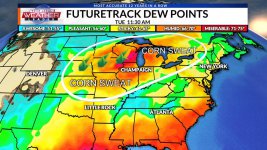It's interesting that we start hearing about this now. There is a lot of new science aimed at trying to measure and determine how plants use water. Much of that research is aimed toward effective plant selection for an environment. (Irrigation or natural rainfall), Many parts of the world struggle to find enough water.
Corn generally has lower evapotranspiration than many other common plants. The term evapotranspiration encompasses evaporation from environment and plant transpiration. It is a little confusing because transpiration is the direct transfer from leaves. High yield corn does have a higher transpiration level than other common crops with higher evapotranspiration.
I'm trying to find a simple method to describe the difference. Tall plants with full ground cover create shade and slow evaporation at soil level. If you are surrounded by tall corn on a warm day, the majority of water moving is through transpiration. The soil itself has slower evaporation. The transpiration process varies a lot with temperature and available moisture. I'm sure most have seen fields of corn with the leaves rolled up. That is the visual evidence of corn "protecting" itself during high temps. It also means that the transpiration process is slowed down. Soil evaporation may increase with higher temps but overall evapotranspiration is lower.
One interesting aspect of corn transpiration is how the moisture is reused by other adjacent plants. During dry years the corn around the outside on fields is stressed more and it shows. There is a term for the stress called edge effect. Corn fields planted next to corn fields will not show the effect in comparison with corn next to beans or grassland.
In some ways it's easier to think of corn like a seasonal forest. Each year the seasonal forest is replanted. Like a forest, the combined acres do have an effect. Compared to a forest, corn has a lower evapotranspiration level. Does that mean we would have higher humidity levels if the midwest was covered in forest? It's a good question. Maybe corn is giving us some hints. There is a field of data being analized as corn acres move into more arid regions. With better plant genetics the western boundry of corn has moved well into the Dakotas. Much of that growth has happened since the early 2,000s.

